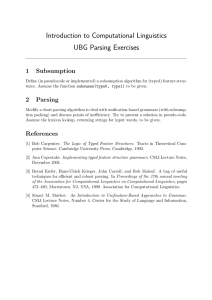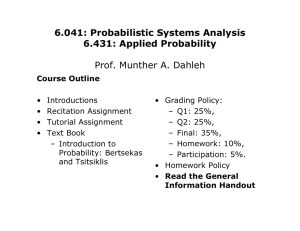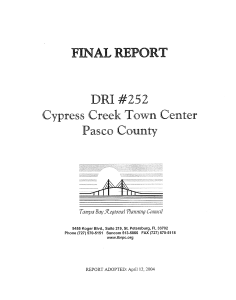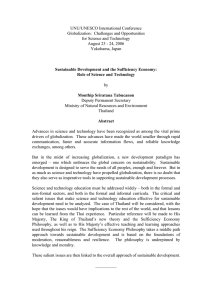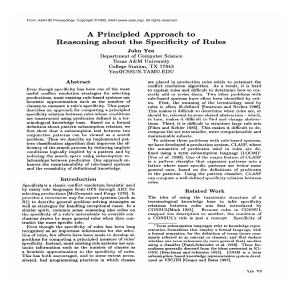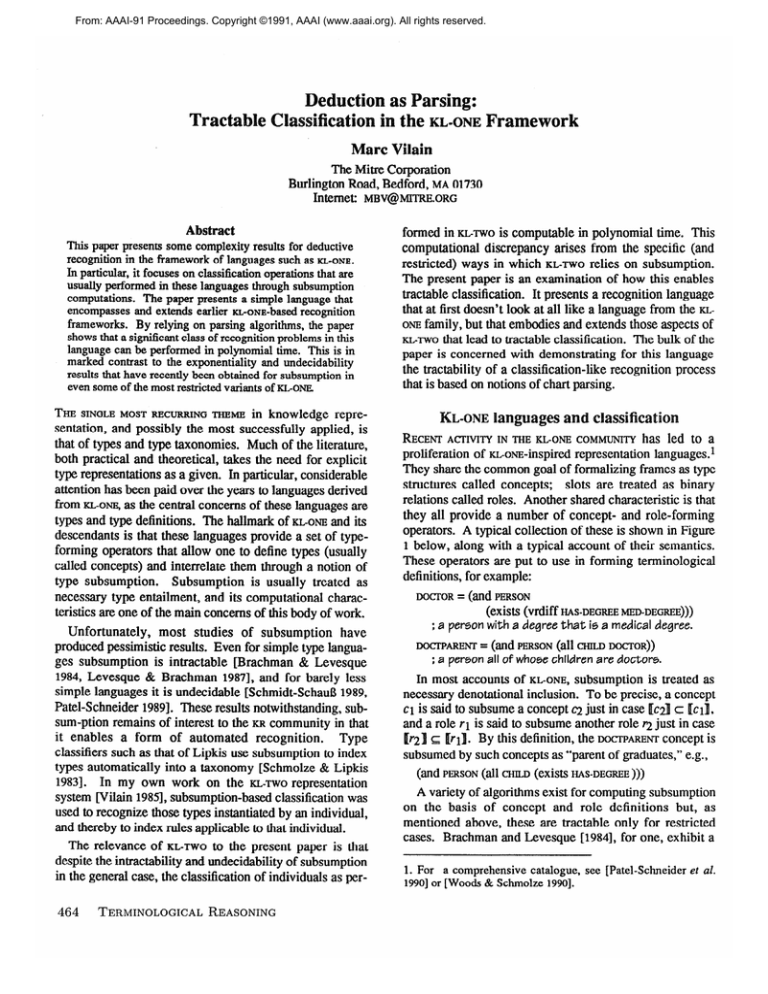
From: AAAI-91 Proceedings. Copyright ©1991, AAAI (www.aaai.org). All rights reserved.
Deduction as Parsing:
in the KL-ONE Framework
Marc Vilain
The Mitre Corporation
Burlington Road, Bedford, MA 01730
Internet: MBV@ATRE.ORG
Abstract
This paper presents some complexity results for deductive
recognition in the framework of languages such as KL-ONE.
In particular, it focuses on classification operations that are
usually performed in these languages through subsumption
computations. The paper presents a simple language that
encompasses and extends earlier m-ONE-basedrecognition
frameworks. By relying on parsing algorithms, the paper
shows that a significant class of recognition problems in this
language can be performed in polynomial time. This is in
marked contrast to the exponentiality and undecidability
results that have recently been obtained for subsurnption in
even some of the most restricted variants of I&ONE
formed in KL-TWO
is computable in polynomial time. This
computational discrepancy arises from the specific (and
restricted) ways in which KL-TWO relies on subsumption.
The present paper is an examination of how this enables
tractable classification. It presents a recognition language
that at first doesn’t look at all like a language from the KLONEfamily, but that embodies and extends those aspects of
KGTWOthat lead to tractable classification. The bulk of the
paper is concerned with demonstrating for this language
the tractability of a classification-like recognition process
that is based on notions of chart parsing.
THE SINGLE MOST RECURRING
THEMEin knowledge representation, and possibly the most successfully applied, is
that of types and type taxonomies. Much of the literature,
both practical and theoretical, takes the need for explicit
type representations as a given. In particular, considerable
attention has been paid over the years to languages derived
from KL-ONE,
as the central concerns of these languages are
types and type definitions. The hallmark of KGONE and its
descendants is that these languages provide a set of typeforming operators that allow one to define types (usually
called concepts) and interrelate them through a notion of
type subsumption.
Subsumption is usually treated as
necessary type entailment, and its computational characteristics are one of the main concerns of this body of work.
Unfortunately, most studies of subsumption have
produced pessimistic results. Even for simple type languages subsumption is intractable [Brachman & Levesque
1984, Levesque dz Brachman 19871, and for barely less
simple languages it is undecidable [Schmidt-SchaulS 1989,
Patel-Schneider 19891. These results notwithstanding, subsum-ption remains of interest to the KRcommunity in that
it enables a form of automated recognition.
Type
classifiers such as that of Lipkis use subsumption to index
types automatically into a taxonomy [Schmolze & Lipkis
19831. In my own work on the KL-TWO representation
system ~ilain 19851, subsumption-based classification was
used to recognize those types instantiated by an individual,
and thereby to index rules applicable to that individual.
The relevance of KL-TWO to the present paper is that
despite the intractability and undecidability of subsumption
in the general case, the classification of individuals as per464
TERMINOLOGICAL
REASONING
L-ONElanguages and dassi
ACTIVITY IN THE KL-ONE COMMUNITY
has led to a
proliferation of ru-oNr5inspired representation 1anguages.l
They share the common goal of formalizing frames as type
structures called concepts; slots are treated as binary
relations called roles. Another shared characteristic is that
they all provide a number of concept- and role-forming
operators. A typical collection of these is shown in Figure
1 below, along with a typical account of their semantics.
These operators are put to use in forming terminological
definitions, for example:
RECENT
DOCTOR=
(and PERSON
(exists (vrdiff r-rAs-DEoru3
~~ED-DEGI~@))
; a person with a degree that
DOCTPARENT=
(andPERso~(all
is a medical degree.
CHILDDOCTOR))
; a person all of whose children are doctors.
In most accounts of KL-ONE, subsumption is treated as
necessary denotational inclusion. To be precise, a co
cl is said to subsume a concept CJjust in case [cd c
and a role rl is said to subsume another role r;! just in case
c [rl]. By this definition, the DOCTPARENT concept is
subsumed by such concepts as “parent of graduates,” e.g.,
(and PERSON (all CHILD (exists HAS-DEGREE)))
A variety of algorithms exist for computing subsumption
on the basis of concept and role definitions but, as
mentioned above, these are tractable only for restricted
cases. Brachman and Levesque [1984], for one, exhibit a
1. For a comprehensive catalogue, see [Patel-Schneider et al.
19901 or [Woods 6%Schmolze 19901.
The semantics of concept- and role-forming expressions is given with respect to to a domain 8 (a set of entities) and a modeling function p
that assigns interpretations in 8 to atomic expressions. That is, p(c) E 6 and p(r) E 6x8, for each atomic concept c and role r. The ci and 5
are either atomic or complex, except in the first row, where they are strictly atomic.
Figure I: Common type-forming operators.
polynomial algorithm for subsumption for the language
defined by atomic concepts and roles, and expressions
formed with the and, all, and exists operators. However,
they then extend the language to include vrdzfexpressions,
and show this leads the computation of subsumption to be
co-NP-complete. Schmidt-Schaug [ 19891 goes further,
showing that the operators and, all, =, and chain are
sufficient to make computing subsumption undecidable.
For another such proof, see @‘atel-Schneider 19891.
In contrast, the process of individual (or instance)
classification can be performed tractably despite being
ultimately based on subsumption. The underlying reason
for this is that instance classification, at least as done in IUTYVO,
does not require the full complement of type-forming
operators that are typically considered in analyzing
subsumption. In KL-TWO, instance classification proceeds
from ground propositions predicated of individuals, e.g.,
(PERSON~&)A(HAS-DEGREE
fred &)A(MED-DEGREE&)
Individuals are classified by generalizing their predicating
propositions to terminological definitions which are then
matched to the terminological database. In this case&&
generalization would be
(and
PERSON
(exists (vrdiff
HAS-DEGREE
MED-DEGREE)))
which (trivially) subsumes the definition of
DOOR.
This kind of classification was used in KL-TWO as the
basis of a deductive rule matcher.2 In this case, rules that
might contain a pattern such as (DOCTOR ?x) could still be
indexed and applied to the individualfred, despite their not
literally matching any ground predication offled.
The reason this instance classification scheme does not
lead to intractability turns out to be due to the impossibility
2. This indexing strategy was first described in the KL-ONE
framework by Mark [ 19821. See also [Schubert, et al. 19791. The
term deductive pattern matcher is due to Mac Gregor [ 19881.
of recognizing directly any concepts that impose universal
restrictions on roles, i.e., concepts defined with the all or =
concept-forming operators. Take the case of DOCTPARENT,
defined as (and PERSON (all CHILD DOCTOR)), and say we have
(PERSONfred) A
(cmfiedrnary)~
(DOCTOR Fna?y)
We are not entitled from this alone to conclude monotonically that (DocTpA~~fied)l This would only be inferrable
if we had, for example, independent knowledge that the set
X) had cardinality
of individuals satisfying h x (cmfred
n-5 1. Knowing this would then allow us to reduce the
definition of DUCTPARENT as a special case to the concept
(and PERSON (exists(vrdiff CHILD DOCTOR))),
which is in fact satisfied by fled.
In the general case, one can show that without recourse
to external non-ground information such as role filler
cardinality, universal restrictions can not be recognized
through instance classification.3
Putting things most
simply, one can not use deduction to recognize universals
from ground facts as doing so is by definition induction.
In effect, the type language recognized by KL-TWO consists of those concepts and roles that are definable with the
and, exists, and vrdifloperators, or that can be reduced to
such concepts and roles through cardinality considerations.
One can readily verify that subsumption in this language
can be computed in polynomial time, and by extension, so
can the process of instance classification performed by I(LTWO(more on this below). This language is clearly rudimentary, but it does suggest a strategy for achieving
tractability of recognition in a more expressive language.
3. As the preceding discussion suggests, KL-TWO relies on this
kind of cardinality information to reduce universal restrictions to
existential ones. Similar ly, the recent CLASSIC system [Bra&man
et al. 19901 provides a close operator to specify that the system
has been given a complete enumeration of the fillers of a role.
VILAIN
465
THE APPROACH ADOPTED HEREdeparts from the KL-ONE
tradition in separating those aspects of a concept’s definition that impose existential restrictions and those that
impose universal restrictions. More precisely, I mean by
the existential aspects of a concept’s definition those
characteristics that are provided by operators whose
semantic account introduces either no variables, or only
existentially quantified variables.
Examples of such
operators are the and, exists, vr&#, and chain operators of
Figure 1. The universal aspects of a concept are those
provided by operators that require the introduction of
universally quantified variables, e.g., all and =.
This distinction between universal and existential
restrictions
is rendered operational
in a simple
representation language called RHO (p), after the Greek
letter for “r” (as in pecognition or pepresentation). RHO
provides two sub-languages for this purpose: an axiomatic
language to state the existential restrictions on a type, and a
frame-like language to state the universal ones. For the
PARENT type, for example, we might state the following.
(pARENT ul)t
(PERS~N~~)+(~I-IILD~~~~)
; i.e., a person for which there exists a child
(frame
PARENT(PERSON(CHILD))
; i.e., all of a parent’s
children are persons
Following the argument in the preceding pages, only the
existential axioms of RHOare used in recognizing instances
of a type z. The universal statements about z are irrelevant
for recognition, and only come into play once instances of
z have been recognized. One can thus think of the axiomatic sub-language of RHO as providing sufficiency rules for a
type, i.e., rules specifying conditions whose satisfaction is
sufficient to guarantee membership in the type. Gonversely, the universal statements can be seen as necessity rules,
contingent conditions that must necessarily hold of
instances of the type. This particular conceptualization of
necessary and sufficient conditions for type membership is
dictated in part by this work’s concern with recognition,
and is thus limited in scope. Nevertheless, the terminology
of necessity and sufficiency affords a convenient operational characterization of the sub-languages of RHO,and as
such will be used throughout this paper.
The first corresponds to a vrdiff role definition in KLONE,
and the second mentions three-place relations, which have
been mostly ignored in xr.-ONE-inspired languages, with
some exceptions (e.g. [Schmolze 19891).
(DAUG~RU~U~)~(CHILDU~U~)+(FEMALE
(PASS-TO UlU2 Uj)C
Ignoring necessity conditions until later in this paper,
sufficiency conditions are specified in RHO with functionfree Horn axioms. In addition to the sufficiency condition
for the PARENT type above (PARENT is a canonical ru-ONE
concept), some examples of this syntax are given below.
466
TERMINOLOGICAL
REASONING
UlU2U3)+(cATaU2U3)
To be precise, the syntax of sufficiency conditions in
RHOfollows the axiom schema below, where the it’ are
predicates, with ai the arity of predicate n!.
The 4 terms in this schema must be either constants or
variables-function
terms are excluded. As is usual with
Horn clauses, variables appearing on both the left-hand
side and right-hand side of a sufficiency condition are
implicitly universally quantified; variables appearing only
on the right-hand side are implicitly existentially
quantified. This is reflected in the names of the variables
in the preceding examples: the ui are universal, and the ei
are existential. As a result of this way of interpreting
variables, sufficiency rules in RHOare precluded from
recognizing universally quantified restrictions such as
those imposed on concepts in LONE by all.
To see this, assume without loss of generality that there
are no constants on the left-hand side of a sufficiency
axiom satisfying the schema above, i.e., no constants in
5’:
l
**
s:,.
The sufficiency axiom can then be factored into a
predicate definition with existential quantification, and a
universally quantified sufficiency assertion.
d=?~$3$(7+$)~---~(7Pi$)
bf i?
wihm
0 $1
The $ designate the arguments of the xi, and 2
designates those variables appearing on the right hand side
of the axiom but not on the left hand side.
For example, the sufficiency axiom for PARENT above can
be rendered into the following existential predicate
definition and universal axiom.
k4rmrr' = hu13
Sufficiency axioms in RHO
(THROW-TO
~2)
V u1 (PARE&
el(pE~sO~ u~)A(CHED
u1)2
(PM
241el)
uJ
For one- and two-place predicates, the predicate definition
can be further expressed in terms of x.r.-ONE-liketypeforming operators, in this case
PARENT'= (and PERSON(~X&S
CHILD))
(andrl . . . r&
(exists rl . . . r,)
[(and rl . . . rr,)] = [rl] n...n
(vrdiff I c)
[(vrdiff r c)] = ( (x, y) E
[mrJ
[(exists rl . . . rnlp =
The domain 6 the modeling function p, concept terms ci and role terms 5 are as in Figure 1.
Figure 2: Type-forming operators for sufficiency axioms.
The reason sufficiency axioms must be factored into two
formulae, one definitional and the other axiomatic, is that
ruro allows several sufficiency axioms to support the recognition of the same left-hand side. For example, a multimedia messaging domain (cf. CONSUL [Mark 19821) might
afford multiple ways of recognizing a priority message:
(PR.Iom-mG ul) + (h&Gul) + (FROM
ul el) + (Boss el)
(PRIORITY-MSG 2~) t
(MSG ul) + (REPLY-BY u1
today)
and so forth. It is clear that though these axioms may each
provide a sufficient recognition criterion for PRIORITY-MSG,
they are not definitional in the traditional KGONE
sense.
Semantics of sufficiency axioms
These notions are formalized through a straightforward
model-theoretic semantics for the language. As usual,
constants denote elements of a domain 6, and a predicate 11:
of arity a denotes a subset of 6 if a = 1, and a subset of
,a x .:. x 5,.
a
if a> 1.
Next, let l,t be a model function for 6, that is, a function
that assigns to a constant K in the language some element
of 6, and that assigns to a predicate K in the language a
subset of the appropriate cross-product of 6 (given the arity
of z). Let p designate a variable binding function that
maps variables among the k terms to constants in the language, and maps constants to themselves. Then i.t is said to
interpret a set of sufficiency axioms if for each such axiom
(ltO&..~”a0 )t(n:
andforanyp,
is in l.t(n’) whenever
1
511 ..y
a1
)+*.*+(lq...gn
an
is in &) for each of the rci. That is, in any model that
interprets the axioms, whenever the right-hand side of an
axiom is instantiated, so is its left-hand side.
RHOand the IKL-ONElanguages
As promised, the syntax of sufficiency conditions in RHO
bears little resemblance to the traditional syntax of KGOFJE
languages. However, as noted above, these conditions can
be factored in part into &ONE-like predicate definitions, for
which it is possible to define a predicate-forming specification language. In general, this language has cumbersome
syntax, mostly because of the need to indicate the coreferences specified by variables in the axioms. Restricting
one’s attention to axioms with predicates of arity 2 or less
(i.e., concepts and roles), it is possible to define a IWMElike language that covers an interesting set of special cases
among these axioms. This language is given in Figure 2.
In addition, one can organize the predicates defined by
these axioms into multiple type taxonomies, one for each
predicate arity. To do so, we just place any predicate Ic’on
the right-hand side above predicate rr” whenever their
arities match (i.e., oi = ok), and whenever
+
+%
i.e., the arguments of n’ are identical to those of x0. The
taxonomies so defined do not encode any subsumption
relations, but they do have the property subsumption
hierarchies have that any instantiation of a predicate ICin
the taxonomy is also an instantiation of all those predicates
above n in the taxonomy.
)
A parsing algorithm for recognition
ONE OF THE ATTRACTIVE CONSEQUENCES
of casting recognition criteria as deductive rules is that this approach leads
to a direct implementation of recognition as a parsing
problem. It may seem unlikely at first that a deductive
process should be amenable to being treated as parsing.
However, deductive recognition is a very particular kind of
VILAIN
467
deduction, and its analogies to parsing are multiple. Just as
grammars allow one to compose syntactic constituents into
larger syntactic units, deductive rules allow one to combine
propositions to deduce oher propositions. Just as a bottomup recognizer starts from atomic “facts” (the positions of
words in a buffer) and proceeds to find all paths to the start
symbol, a forward-chaining deductive recognizer starts
from base propositions and deduces all their consequences.
The recognition strategy adopted here is based on
notions of bottom-up chart parsing. As syntacticians will
notice, not all characteristics of this kind of parser actually
come to bear on deductive recognition. By casting the
problem in this way, however, the computational properties of the recognition problem in RHOare made clear.
The principal data structure in a chart parser is the chart
[Kay 19801, a two-dimensional table indexed by buffer
position that records which constituents have been parsed
out of the buffer. Letting Ch designate the chart, a given
constituent x E Ch[i, jl just in case x has been parsed out
of the buffer between positions i and j. For deductive
recognition, the chart is an a-dimensional table, where a is
the maximal arity of predicates in the recognition rules.
Chart cells are indexed by individual constants of the
language. If a proposition (Z rcl . . . rcn)has been given as a
premise, or has been deduced from other propositions, then
n is entered in cell Ch[rci . . . Kn] of the chart . For expository purposes, one can assume that Ch is implemented as
an a-dimensional array A. The chart entry indexed by
individuals ~~ . . . Kn is thUSA(NKl),...,
N(Kn),O,...)0),
where Nis a function that returns an integer code (2 1) for
each constant Ki and the O’s fill in any missing indices of A
if the Kiare fewer than a in number. This storage strategy
is clearly simple-minded and wasteful of space; many
improvements are possible (see Wllman 1988,1989]).
The deductive recognition process operates bottom up,
and as with many syntactic recognizers for context-free
languages, intermediate states of recognition are encoded
as “dotted rules” Barley 19701. Initially a rule’s dot is to
the left of the first term on the right-hand side. If this term
matches an entry in the chart, a copy of the rule is created
that advances the dot past the matching term, indicating
that this new rule must match on its second term. This
process of creating dotted rules is continued until the righthand side is exhausted, whereupon the left-hand side is
added to the chart. As with unification grammars [Shieber
19861, the variable bindings that ensue from matching a
term to a chart entry are associated with the resulting
dotted rule, and are consulted in subsequent matches. For
further details on this process, and for specific algorithms,
see Barley 1970; Kay 1980; or Shieber 19861.
468
TERMINOLOGICAL
REASONING
It is straightforward to verify that this parsing algorithm
correctly computes all the deductions sanctioned by a set
of sufficiency rules. In effect, the chart implicitly defines
a modeling function ll.: @(K1) . . . p(Kn))E ll.(lc) just in
case II:is entered into the chart in cell Ch[q . . . ~1. That
this ~1provides an interpretation of the sufficiency rules
follows directly from the way the parsing process adds
entries into the chart.
The computational complexity of this algorithm, unfortunately, is unappealing. In the general case, unification
grammars have the formal power of a Turing machine.
This result does not fully apply here, principally because
function symbols are barred from the recognition rules.
Nevertheless, the problem of computing the deduction
sanctioned by sufficiency rules can be readily shown to be
w-complete, by reduction from subgraph isomorphism or
from conjunctive Boolean query [Garey & Johnson 19791.
The reduction from subgraph isomorphism is of
particular interest, as it helps reveal a tractable subclass of
deductive recognition problems. The reduction proceeds
by mapping the matching graph (the putative subgraph)
into a recognition rule. For each node nl . . . nn in the
matching graph, a variable v1 . . . v, is created, and for each
vertex from n; to nj, the term (CONNECTS vi yj) is added to
the rule. The rule’s left-hand side is the term (SG v1 . . . vn).
The target supergraph is then mapped to ground
propositions (CONNECTS mi ~9, where mi and mj are target
graph nodes. The matching graph is isomorphic to a
subgraph of the target just in case (SG m 1.. . mn) is
recognized for some ml.. .mn.
Achieving tractability
This reduction demonstrates that the potential computational burden of deductive recognition arises from the need
to perform arbitrary graph matching to instantiate a rule.
This suggests that if one could restrict deductive rules so as
to preclude graph matching, recognition might be tractable.
The following criterion provides such a restriction.
The criterion is based on a partial order L defined by the
existential variables introduced on the rule’s right-hand
side. Starting from the universal variables ui on the lefthand side, which are clustered as the bottom element of L,
an undirected graph of the partial order is obtained by
consulting terms on the right-hand side in order of
decreasing arity. If a term mentions variables v1 . . . vi that
are already in the order and variables Vj . . . Vnthat are not,
a cluster c containing Vj . . . vn is first added to the graph.
Then, for any two variables (old or new) in v1 . . . vn, an
undirected link is added between their variable clusters,
provided there is not already a path between the two that
only mentions the variable clusters of vr . . . v,. The rule is
said to define a variable tree just in case the graph of L is a
tree rooted at the ui cluster. Note that the examples given
earlier in this paper meet this criterion, as does any rule
equivalent to an expression formed with the operators in
Figure 2. For example, the first sufficiency axiom given
above for PARENT,
(PARENT U~)t(PERSONU~)+(CHILDU1
el),
only has two variables, which are clustered and ordered as
{ui) L ( el). This trivially defines a variable tree.
Given this notion, it can then be shown that recognition
over any set of rules that define variable trees can be
performed in polynomial time. The proof proceeds by
estimating the amount of matching necessary to instantiate
the left-hand side of a rule r. Say 1~1is the total number of
constants appearing in ground propositions, and a is the
maximal predicate arity in the rules. Then to obtain all
possible consistent instantiations of the variables in a
variable cluster of r can only require O(IK~~) matches.
Because r defines a variable tree, at most another O(l~l~)
matches are necessary to relate the cluster to all other
clusters for r. The number of such clusters is bounded by a
parameter 151,the maximal number of variables in a rule.
The total number of left-hand side instantiations is again
bounded by IKIae The overall cost of fully instantiating the
left-hand sides is thus 0(1&lIK~~), a polynomial in IKI with
141and a as parameters.
Further issues
The preceding result demonstrates that despite the undecidability of subsumption in most xGoNr+like languages,
the related problem of instance classification, or recognition, is in fact tractable to a significant degree. That is the
main result of this paper. Beyond this, a number of issues
remain that I would like to address before closing.
Universal conditions
The discussion to this point has largely ignored the
specification of universal restrictions,
such as the
selectional restrictions on predicates that one might want to
impose in order to state, e.g., that all of a person’s children
are persons. As I suggested above, RHO provides universal
(or necessity) conditions such as these with a simple frame
language, in this case:
(frame
P~E~(PERSON(CHILD)).
The details of RHO'S necessity language are not of great
interest here. By a fairly pedestrian set of meaning postu-
lates, statements such as the preceding are interpreted as
universal restrictions on the fillers of relations, in this case:
V X~(PARENTX)A
(cm
x,y)z
(PERsoNy).
In a somewhat perverse twist, it is worth pointing out that
necessity conditions can actually be recast in terms of
r2no’s sufficiency rules, as in (PERSON y) t (cm
x y).
RHo in perspective
I should note that though the framework adopted here is
loosely based on chart parsing, that is not strictly
necessary. The notion of implementing deduction with
parsing strategies is, I would hope, both provocative and
amusing, but in truth it is related to the way rule matching
is implemented in certain forward-chaining rule languages,
for example MAllester’s RUP [McAllester 19821. An
interesting topic of further study would be to compare the
performance, theoretical and actual, of this “parsing
deducer” to that of traditional forward-chaining architectures such as OPSJ [Forgy 19821 or TREAT [Miranker 19871.
In closing I should acknowledge that there are signilicant representational issues lurking behind this work. By
separating existential and universal and existential restrictions, and by making their semantics implicational (as
opposed to biconditional), RHO rejects the standard KGONE
notion of necessary and sufficient type definitions. Along
these lines, a counter-example that has been levelled in
criticism of this work is the concept of an all-girl school. It
is easy to define this concept in KGONE, but no non-trivial
sufficiency axiom can be given for it in RHO. Such
criticisms are certainly valid, but are somewhat beside the
point. The whole point of this work is to support deductive
recognition from ground facts; recognizing an all-girl
school by observing its students’ gender is a nonmonotonic inference that is inductive in nature.
As a point of speculation, my suspicion is that progress
towards this particular non-monotonic reasoning problem
will come from representational approaches that pay
attention to issues of learning. Research is proceeding in
this direction, including some of my own [Vilain, Koton &
Chase 19903. This area holds much promise for the future
3 Acknowledgements 3
This research was begun while I was affiliated with Bolt,
Beranek, and Newman Inc. (BBN), where Remko Scha
offered much patience and attention. Bill Woods and
Steve Minton provided critical insights, and Ellen Hays
provided incisive criticism. I also owe much gratitude to
the Arnold Arboretum of Harvard University for providing
the setting in which these ideas were first developed.
VILAIN
469
References
Brachman, R. J. & Levesque, H. J. (1984). The tractability
of subsumption in frame-based description languages.
In Proceedings of the Fourth National Conference on
Artificial Intelligence (AAAI~~), Austin, TX,34-37.
Earley, J. (1970). An efficient context-free parsing
algorithm. Communications of the ACM
13: 84-102.
Reprinted in [Grosz et al. 19861.
Forgy, C. L. (1982). A fast algorithm for the many
pattern/many
object pattern matching problem.
Artificial Intelligence 19: 17-37.
Garey, M. R. & Johnson D. S. (1979). Computers and
intractability: a guide to the theory of Np-completness.
New York, NY: W. H. Freeman and Co.
Proceedings of the First International Conference on
Knowledge Representation @x89), Toronto, 432-443.
Schmolze, J. G. & Lipkis, T. (1983). Classification in the
KL-ONE
knowledge representation system. In Proceedings of the Eighth International Joint Conference on
Artificial Intelligence (LJCAI~~),
Karlsruhe, Germany.
Schmidt-SchauB, M. (1989). Subsumption in KL-ONE is
undecidable. In Proceedings of the First International
Conference
on Knowledge
Representation
(1~~891,
Toronto, 421-431.
Schubert, L. K., Goebel, R. G., & Cercone, N. J. (1979).
The structure and organization of a semantic net for
comprehension and inference. In Findler, N. V., ed.,
Associative networks: Representation and use of knowledge by computers. New York, NY: Academic Press.
Grosz, B. J., Sparck Jones, K., & Webber, B. L., eds.
(1986). Readings in Natural Language Processing. Los
Altos, CA: Morgan-Kaufmann Publishers.
Shieber, S. M. (1986). An introduction to unification-based
approach
to grammar. CSLI lecture notes no. 4.
Distributed by University of Chicago Press.
Kay, M. (1980). Algorithm schemata and data structures in
syntactic processing. Technical report ~~~-80-12, Xerox
Palo Alto Research Center. Reprinted in [Grosz et al.
Ullman, J.D. (1988). Principles of database and knowledge-base systems, vol. 1. Rockville, MD: Computer
Science Press.
19861.
Levesque, H. J. & Brachman, R. J. (1987). Expressiveness
and tractability in knowledge representation and
reasoning. Computational Intelligence 3: 78-93.
Mark, W. S. (1982). Realization. In Schmolze J. G., and
Brachman, R. J., eds. Proceedings of the Second KL-ONE
Workshop. Technical Report No. 4842, Bolt Beranek
and Newman, Inc., Cambridge, MA,78-89.
McAllester, D. A. (1982). Reasoning utilities package
user’s manual. AI memo 667 MITAI Lab.
Mac Gregor, R. M. (1988). A deductive pattern matcher.
In Proceedings of the Seventh National Conference on
Artiftcial Intelligence (AAAI~~),
Saint Paul, MN,403-408.
TREAT: A new and efficient match
algorithm for ai production systems. PhD dissertation,
Miranker, D. P. (1987).
Dept. of Computer Science, Columbia University.
Patel-Schneider, P. F. (1984). Undecidability of subsumption in NIKL. Artificial Intelligence 39: 263-272.
Patel-Schneider, P. F., Owsnicki-Klewe, B., Kobsa, A.,
Guarino, N., Mac Gregor, R., Mark, W. S., McGuiness,
D. L., Nebel, B., Schmiedel, A., & Yen, J. (1990). Term
subsumption language in knowledge representation. AI
Magazine ll(2): 16-23.
Schmolze, J. G. (1989).
Terminological knowledge
representation systems supporting n-ary terms. In
470
TERMINOLOGICAL
REASONING
Ullman, J.D. (1989). Principles of database and knowledge-base systems, vol. 2. Rockville, MD: Computer
Science Press.
Vilain, M. B. (1985). The restricted language architecture
of a hybrid representation system. In Proceedings of
the Ninth International Joint Conference on Artificial
Intelligence (ucAI~~), Los Angeles, CA, 547-551.
Vilain, M. B., Koton, P. & Chase, M. P. (1990).
analytical and similarity-based classification.
On
In
Proceedings of the Eighth National Conference on
Artt$cial Intelligence (AAAI~~), Boston, MA,867-874.
Woods, W. A. & Schmolze, J. G. (1990). The KGONE
family. To appear in Computers and Mathematics with
Applications, special issue on semantic networks in
artificial intelligence.
Also available as Technical
Report ~~-20-90, Aiken Computation Lab, Harvard
University.


